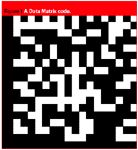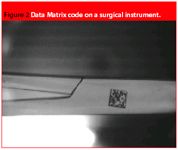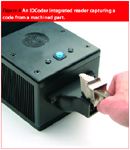When Simple Isn't Good Enough
Pharmaceutical Technology Europe
Although there is no global regulation or industry standard on labelling requirements, some organizations are beginning to lay down their own standards.
If you need to know how many boxes of washing powder or cans of beans you've sold, then conventional one-dimensional (1D) barcodes do the job. But if you work in a cutting-edge industry where an incorrect product verification or a labelling mistake could lead to loss of life or a costly lawsuit, then you need a more robust and secure labelling solution.
A simple barcode, usually printed on a sticky label, may not be readable when needed — assuming it hasn't simply fallen off through abrasion, extreme temperature or solvent action. So in the search for a more reliable solution, high-tech manufacturers, such as the aerospace industry and, increasingly, the pharmaceutical industry, are adopting the next generation of labelling: two-dimensional (2D) Data Matrix codes.
Barcodes are not being replaced by Data Matrix codes, but new options for traceability and quality control (QC) have opened up possibilities for companies to embrace this new technology. In some situations, the two labelling methods can be used side-by-side, which calls for a new generation of code readers that can cope with both code formats.
Barcode applications and drawbacks
The first coded labelling technology — barcodes — was applied in the US supermarket industry 30 years ago. The barcode (a 1D code) stores information in an array of lines, scanned from left to right, or vice versa, using a laser beam. The data is encoded within the width and order of these lines and spaces, which has implications for the minimum size of a barcode needed to carry the data.
The practical data capacity of barcodes is usually less than 20 characters, limited by the size of barcodes and the accuracy with which they can be printed. This severely reduces the number of unique identifying codes that can be generated for batches and the amount of information that can be held on a product. To work around this problem, manufacturers have used barcodes to access information held on a remote database, but this relies on external communications links, secure access protocols and central storage computers that never crash.
Barcode technology also places demands upon the label printing technique to reproduce critical line widths accurately and ensure the necessary degree of contrast between lines and background. This usually confines producers to printing the labels separately before applying them to a product. These activities can be surprisingly expensive to achieve automatically when compared with the variety of techniques available for direct part marking (DPM), which carries negligible consumable costs after a higher initial capital outlay.
Barcodes are susceptible to being made illegible to laser scanners in the most benign of environments if dirtied, attacked by chemical agents, scratched or distorted along their principle axis — as anyone who spends time stuck in a supermarket checkout can testify!

Figure 1. A Data Matrix code.
However, the inherent qualities of 2D Data Matrix codes avoid these problems while adding a whole range of new capabilities for the manufacturer to take advantage of.
What are 2D Data Matrix codes?
Instead of a linear array of black and white indicators, Data Matrix codes are a square or rectangular array of cells. Each cell can either be filled or empty, storing information in binary code on a miniaturized 'chequerboard' (Figure 1).
Using two dimensions greatly increases the amount of data that can be stored in a given space, allowing miniaturization while offering a huge number of permutations. Not only can products be more precisely identified, but their complete history of production, QC, packaging and handling can be confidentially encrypted within their labels.
Data Matrix codes are also far more rugged than barcodes and are readable even when damaged by up to 24%. Each code label incorporates an integral error correction code (ECC). The preferred format for the Data Matrix is ECC200, which uses a Reed Solomon algorithm to recover data by linking every dot in the Data Matrix to the rest of the code.1
A recent study conducted by a US university found that the chance of a misread on a 2D code was less than 1 in 10.5 million. 2D codes can even be read if the label has growth or compression in either axis, making them particularly useful in extreme environments such as marking directly onto surgical instruments or weaving the Data Matrix pattern into a fabric for traceability of sterile work-wear (Figure 2).2
The combination of small size, readability from any angle, low contrast requirements and damage tolerance means these codes are ideal for applying to almost any packaging surface – including foil, glass, plastic or metal and even directly onto products, from contact lenses to surgical equipment, medicine bottles to inhalers.

Figure 2. Data Matrix code on a surgical instrument.
A wide variety of marking methods can also be used, including thermal transfer, ink jet, laser etch, laser colour change imaging, as well as dot peening. A density of two characters per square millimetre is quite easy to achieve. Directly marked labels become a part of the product and are, therefore, as durable and permanent as the item itself. They will resist solvents, heat and all but the most aggressive abrasion.3
Reading 2D Data Matrix codes
The codes are read by an increasingly sophisticated array of image technology backed up by software that interprets those images, allowing for far less contrast and more reliable image capture in variable environments. Technology development in 2D code reading can be done in an innovative and cost-effective way. Expensive components do not have to be used — a vision system has a job to do, which in the field of tracking ingredients or ensuring correct packaging, is a relatively straightforward application.
A variety of code readers exist depending on the stage of process (Figure 3). High-speed fixed head readers take digital pictures of the individual codes, analyse and verify them before checking the information tallies and storing it. The reader software can be integrated within the production line.
Smart camera-based readers that can function independently, without being linked to a PC, or in a networked environment using Ethernet connectivity, are also available. These readers combine light emitting diode lighting, image capture, decoding and communication interfaces in a single compact product.
Readers are available for industrial use in packaging, pharmaceuticals and healthcare, and are able to read moving objects at speeds of over 6 ms-1 , 60 times a second, making them suitable for the production line environment. New product codes can be introduced into the reader at the push of a button, and diagnostic software tools enable real-time monitoring of code printing, quality, position and orientation, exposure quality and decoding time.

Figure 3. A range of code readers for biotechnology, pharmaceutical and healthcare markets.
For lower throughput environments or in the field, portable, hand-held readers are available to weed out counterfeit, out-of-date or misdirected products.
The cost of many portable, cordless readers is now on a par with barcode laser scanners and many can even do both jobs. There are significant differences between label readers, but some products can now read reduced space symbology (RSS) and barcode labels, as well as 2D Data Matrix codes. This multi-reading capability is an obvious business benefit for any company that may be handling products with a mix of marks. There are even innovative readers on the market that combine hand-held and fixed configurations, offering the choice of universal serial bus serial cable to laptop or cordless Bluetooth communications (Figure 4).
The density of information on a Data Matrix code and the freedom of readers from a central database allows on the spot checking of information encoded on parts used during manufacturing. The accuracy of data acquisition is vital where traceability and quality control are key elements of the process. Yet operators of a hand-held system usually require only basic familiarization with the product.
Code readers have also been designed to read premarked tubes from all of the major laboratory equipment manufacturers.

Figure 4. An IDCoder integrated reader capturing a code from a machined part.
Advantages to Industry
The ability of 2D Data Matrix codes to carry large amounts of data discretely and in encrypted form offers a number of advantages to the pharmaceutical industry.
Industrial machine vision is becoming ever more critical to the manufacturing process in many markets. Vision systems are used for checking quality in a world where every manufacturer at each stage of the production process is striving for 100% quality assurance (QA).
2D code marking of parts provides a unique identifier to each individual product. Code reading using a vision system ensures traceability of every part, so a company can instantly know where a component has come from and also know that it has passed a QA process.
Small-scale operators will appreciate this innovative approach while larger companies benefit from financial economies of scale, and the reduction in errors of accuracy, storage and retrieval problems. Within the modern, centralized pharmaceutical manufacturing industry a product will be packaged, but held in an unlabelled state until called for by the order processing department — known as 'bright stocking'. The destination country and language of the label to be applied remains unknown until the item is called for despatch.

Key points
Problems arise because of this separation of the filling and labelling operations, and the majority of product recalls are a result of a mismatch of packaging, insert, or both. One technique used to avoid these errors is to apply a product code and batch number directly onto the unlabelled container at the filling stage.
Until recently, automatic product identification was only possible using a traditional barcode printed on the outer carton of a product during the final stages of manufacture. As the product components within a carton often don't contain a detailed code, they are not open to routine automatic checking during the earlier stages of production.
The unique qualities of the Data Matrix code allow it to be applied directly to almost any surface, including glass and metals, without the need for a traditional label. The code on each container can then be automatically read at the labelling station, compared with a similar code on the label being applied and any leaflet insert required, and ensure that the correct match is achieved. Any mismatch between the two codes will immediately stop the process and alert an operator.4
The small area needed for Data Matrix coded labels keeps the manufacturers' marketing departments happy by avoiding disfiguring on the package with 'production' marks.
The greater data density of 2D Data Matrix coding means a simple image reader connected to a laptop computer can decode the full history of the item without accessing remote databases, with the attendant security implications. This gives manufacturers and distributors a trace and track capability to ensure the item is genuine and has been through appropriate QC stages by making its complete life history available at the point of scanning.
Because an item's production details can be narrowed so specifically to sub-batch level, including details of when and on which machine it was produced, and protected by confidential encryption, it makes it that much harder for counterfeit goods to escape a checker with the appropriate equipment, protecting the brand and the consumer.
The specific life history is also advantageous because manufacturing errors can be narrowed down to a small set of products resulting from, for example, a faulty machine or precursors. The number of recalled items can be drastically reduced, making the difference between a few discrete letters to retailers or consumers and a worldwide public relations campaign to clear supermarket shelves and warn potential users, with all the attendant publicity.
Pharmaceutical applications
One of the qualities of the Data Matrix code is that it can be printed in a very small size, down to 3 mm2 printed by an inkjet printer, and considerably smaller by a new technique using laser imaging onto a specially treated surface. This means that it can be used in the same way as a barcode, but with different applications. For example, it can be applied to foils and blister packs for contact lenses by inkjet, laserjet printer or laser colour change imaging. When smaller products, such as asthma inhalers, injectables and contact lenses, must be sealed they cannot be labelled. So the manufacturer can 'invisibly' mark individual doses with critical batch and contents information by using the information-dense Data Matrix.
Inhaler canisters are a typical application — once filled, they are weighed, put into a store, and then weighed again before being distributed for sale. In the meantime, to avoid mixing up the canisters, manufacturers can mark directly onto the base of the canister using an inkjet printer. The reader can easily cope with reading codes marked on the canisters, which are made of metal alloy or shiny steel, and have a concave surface.
In pharmaceuticals, it has to be said that Data Matrix is most usually applied to product at the packaging stage. However, it is feasible to inkjet or laser mark the code directly onto a tablet, for product identification during drug trials, for example. Therefore, an active ingredient could be distinguished from a placebo, but only by a qualified person equipped with a reader.
Encrypting the data carried within the Data Matrix offers a further level of security and prevents the unauthorized access to the information contained.
Another application is for use of 2D code in ultraviolet (UV) ink on packaging, when a customer is sensitive about having any form of mark disfiguring the packaging design, or when they wish to use stealth marks for traceability of goods for anticounterfeiting purposes. A barcode would not be appropriate for use in UV ink as it would not be man-readable and the process could not be automated in the same way as with Data Matrix.
The push for tighter controls
Large-scale consumers are increasingly demanding the ability for suppliers to track their products from production to use. Although there is no global regulation or industry standard on labelling requirements, some organizations are beginning to lay down their own standards.
The US Department of Defence has introduced its unique identification (UID) programme that requires most items supplied to the US armed forces to be labelled this way (i.e., Data Matrix). The trend is proliferating as the same suppliers offer these advantages to other organizations; it will almost certainly have an impact on medical and pharmaceutical items supplied to the Department of Defence.
The UID has a standard data content based upon the MIL130 format and it remains to be seen whether this format will be adopted in the non-military market. The consumer-led push has caused the US-based Health Industry Business Communications Council (HIBCC) to create a standard, mainly for the US, that is also being applied by companies in Europe.
The main FDA stipulation is regarding print quality of codes, which should comply with the AIM/ISO standard 16022. This standard defines a range of print quality grades ranging from 'A' (excellent) to 'D' (acceptable). Most packaging specifications require codes to be of Grade C or better. The data content is usually application-specific and includes date and batch information.
2D Data Matrix-coded labels are the only practicable means of storing enough information on each item, no matter how small, to comply with demands. Any company that cannot comply is going to be left out.
The pharmaceutical industry is driven by imperatives not foreseen when barcodes were introduced and modern standards have far outstripped the capabilities of older storage and retrieval technology. Verification with 2D Data Matrix gives producers and users the confidence that an item is exactly what it should be, which means easier detection of counterfeit products and fewer costly mistakes during the manufacturing and packaging stages.
References
1. ISO/IEC 16022 Standard, British Standards Institution, 389 Chiswick High Road, London W4 4AL, UK.
3. NASA Specification NASA-STD-6002, Materials, Processes and Manufacturing Department, ED30, MSFC, AL 35812, USA.
4. ANSI MH10.8.7, Labelling and Direct Product Marking with Linear Bar Code and Two-Dimensional Symbols, American National Standards Institute, 25 West 43rd Street, 4th Floor, New York, NY 10036, USA.
Charlie Plain-Jones is European sales manager at Absolute Vision Ltd, UK.
Entering New Domains for 3D Printing of Drug Products
April 6th 20253D printing of personalized medications is currently possible under existing compounding regulations, offering enhanced process control through automation. But new legislation coming in 2025 will allow 3D printing as part of a distributed manufacturing framework.
Drug Solutions Podcast: Applying Appropriate Analytics to Drug Development
March 26th 2024In this episode of the Drug Solutions Podcast, Jan Bekker, Vice President of Business Development, Commercial and Technical Operations at BioCina, discusses the latest analytical tools and their applications in the drug development market.
Drug Solutions Podcast: Drug Packaging and Sustainability Essentials
April 4th 2023Lon Johnson, VP of Sales and Marketing at Colbert Packaging Corporation, discusses the latest drug packaging updates and how companies can become more sustainable with Pharmaceutical Technology editor Jill Murphy.
